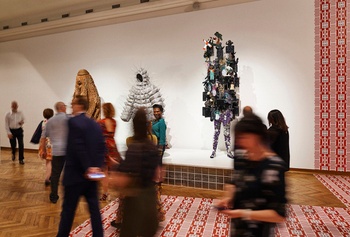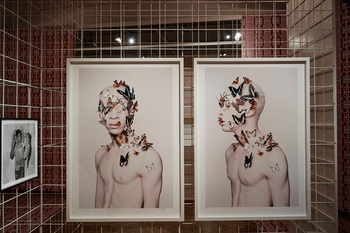For “IncarNations”, artist Kendell Geers dived into the African art collection of the Congolese collector Sindika Dokolo, and resurfaced with a series of classic and contemporary works that shatter the European myth of African art and counteract it with a scintillating spirit and penetrating gaze.
By definition the spirit is alive. It is something that is fluid, something that is coming out of you. It’s an energy, a life force. It is something you believe in, something that gives you a reason to get up in the morning. It’s more than five senses and three dimensions.” This spirit is the crux of the exhibition “IncarNations”, which Bozar is organizing over the summer. The spirit that inhabits art, gives it life, and makes the spaces in which we encounter Kendell Geers vibrate. The South African, Brussels-based artist dived as a curator into the collection of the Congolese businessman Sindika Dokolo, one of the world’s biggest collectors of classic and contemporary African art. “In ‘IncarNations’ we wanted to look at art from a different point of view, from an African perspective. What might make African art different than other practices? What unites these artists within the differences? That’s where the idea of a spiritual practice came to the fore, a spirit that still resonates through contestation, protest politics, contesting power relations, the search for identity...”
It was a masterstroke to make the leitmotif of the exhibition run all the way through from classic African art – Congolese Tabwa and Nkisi figures, Pende masks, Mano masks and Akan combs from Côte d’Ivoire, a Mahongwe Boho-na-bwete figure from Gabon, or a Dogon figure from Mali – to imposing twentieth-century and contemporary artists like Malick Sidibé, William Kentridge, Jean-Michel Basquiat, Roger Ballen, Pascale Marthine Tayou, Jane Alexander, Kehinde Wiley, Andres Serrano, Nick Cave, Gavin Jantjes, Otobong Nkanga, Sammy Baloji, and Stan Douglas. And to artists who have been forgotten here, like Ernest Mancoba, one of the founders of the CoBrA movement, and young artists like Léonard Pongo and Bianca Bondi. “Africa is ongoing. It is transforming and shifting, adapting to new challenges and technologies, adapting to the shifts and changes of daily possibilities. Classic African art was never made for a display case, it was made to be lived. The rooted experience is what generates the object. That living spirit fills this space.”

Dark Matter
“African art is life,” Hank Willis Thomas says in the catalogue of “IncarNations”. “It is dark matter – invisible, omnipresent, unattainable, and uncontainable. In our global culture, Africa’s eclectic influence is ubiquitous. African art (and life) is at the epicentre of modernity and its impact on Western society is copious.” He thus articulates one of Kendell Geers’s ambitions for the exhibition. “It is questioning existing ideas of Africa, like this European fantasy that Africa is somewhere isolated, somewhere that needed to be discovered. Africa was never discovered. It was always on the other side of the Mediterranean and it has always been part of the dialogue with Europe. ‘IncarNations’ invites a new reading. To demythologize African art, to make it accessible, to make it something that we can appreciate as equal, sometimes even better than European art.”
“That is also why there are no works of art on the walls but mirrors and wallpaper. The money that funded the building comes, if not directly then indirectly, from Congo, through rubber and ivory. So we’re exhibiting the building as well. And the visitors. Through the mirrors, their perceptions, their prejudice, their fears, and their desires are as much part of the exhibition as the works of art. And that’s an invitation to deconstruct your prejudice and come with an open mind to reconsider what Africa might be.” “Because Africa,” Kendell Geers continues, “is not singular. It is not preconceived, you cannot reduce it to anything. It is contradictory and complex. Africa is fifty-four different countries, over 2,000 living languages, and from the Maghreb to South Africa, you have black people and white people, animists, fundamentalists, and jihadists, all living on the same continent.”

“IncarNations” shows all this through the eyes of African artists and inspired African art. “These are African people representing themselves, speaking for themselves, trying to define themselves. Over the years of struggle, they appreciate identity, they don’t take it for granted. It is something worth fighting for.” This becomes visible in the historical section of the exhibition, which focuses in part on the Black Panthers, the African American movement that struggled for equality, for the right to speak and to be heard. But it is also visible in the Turner Prize-winning Lubaina Himid’s 1980s sculpture Family Man, which attacks power relations from a feminist and African perspective, or Hank Willis Thomas’s more recent Crossroads, a photographic work on the complexity of identity and the influence of perspective.
“This exhibition is about Africa rising, Africa for itself,” Kendell Geers says. “IncarNations” embodies that spirit. In art that pulsates, that grabs you by the scruff of the neck, and which demands that you remove your blinkers. “And when you look at an African work of art, it looks right back at you.”
Read more about: Brussel-Stad , Expo , culture
Fijn dat je wil reageren. Wie reageert, gaat akkoord met onze huisregels. Hoe reageren via Disqus? Een woordje uitleg.